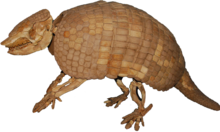Pampatheriidae
- Machine translation, like DeepL or Google Translate, is a useful starting point for translations, but translators must revise errors as necessary and confirm that the translation is accurate, rather than simply copy-pasting machine-translated text into the English Wikipedia.
- Consider adding a topic to this template: there are already 9,156 articles in the main category, and specifying
|topic=will aid in categorization. - Do not translate text that appears unreliable or low-quality. If possible, verify the text with references provided in the foreign-language article.
- You must provide copyright attribution in the edit summary accompanying your translation by providing an interlanguage link to the source of your translation. A model attribution edit summary is
Content in this edit is translated from the existing German Wikipedia article at [[:de:Pampatheriidae]]; see its history for attribution. - You may also add the template
{{Translated|de|Pampatheriidae}}to the talk page. - For more guidance, see Wikipedia:Translation.
| Pampatheriidae Temporal range: Middle Miocene–Holocene PreꞒ Ꞓ O S D C P T J K Pg N | |
|---|---|
 | |
| Holmesina occidentalis | |
| Scientific classification | |
| Domain: | Eukaryota |
| Kingdom: | Animalia |
| Phylum: | Chordata |
| Class: | Mammalia |
| Order: | Cingulata |
| Family: | †Pampatheriidae Paula Couto 1954 |
| Genera | |
| |
Pampatheriidae ("Pampas beasts") is an extinct family of large cingulates related to armadillos. They first appeared in South America during the mid-Miocene, and Holmesina and Pampatherium spread to North America during the Pleistocene after the formation of the Isthmus of Panama as part of the Great American Interchange. They became extinct as part of the end-Pleistocene extinctions, about 12,000 years ago.[2]
Taxonomy
The placement of the Eocene genus Machlydotherium in the family is considered doubtful. The oldest undoubted member of the group is Scirrotherium from La Venta, Colombia, dating to the mid-Miocene.[2]
Description
Pampatheres are believed to have attained a weight of up to 200 kg (440 lb). Like three-banded armadillos, and unlike glyptodonts, their armored shell was given some flexibility by three movable lateral bands of scutes.[3] The osteoderms (bony plates in the skin comprising the armor) of pampatheres were each covered by a single keratinized scute, unlike osteoderms of armadillos, which have more than one scute.[3]

A study of pampathere jaw biomechanics showed that their masticatory musculature was more powerful and more adapted for transverse movements than that of armadillos, leading to the conclusion that much of their diet was coarse vegetation. They are thought to have been primarily grazers, unlike armadillos, which are omnivorous or insectivorous.[3] The variation between species in the expression of adaptations for grinding coarse vegetation correlates with the aridity of their habitat; such adaptations are most pronounced in Pampatherium typum, which lived in the arid Pampas, and least pronounced in Holmesina occidentalis, which lived in humid lowlands.[4]
References
- ^ Flávio Góis; Laureano Raúl González Ruiz; Gustavo Juan Scillato-Yané; Esteban Soibelzon (2015). "A Peculiar New Pampatheriidae (Mammalia: Xenarthra: Cingulata) from the Pleistocene of Argentina and Comments on Pampatheriidae Diversity". PLOS ONE. 10 (6): e0128296. Bibcode:2015PLoSO..1028296G. doi:10.1371/journal.pone.0128296. PMC 4470999. PMID 26083486.
- ^ a b Góis, Flávio; Scillato-Yané, Gustavo Juan; Carlini, Alfredo Armando; Guilherme, Edson (June 2013). "A new species of Scirrotherium Edmund & Theodor, 1997 (Xenarthra, Cingulata, Pampatheriidae) from the late Miocene of South America". Alcheringa: An Australasian Journal of Palaeontology. 37 (2): 177–188. doi:10.1080/03115518.2013.733510. hdl:11336/18791. ISSN 0311-5518. S2CID 129039539.
- ^ a b c Vizcaíno, S. F.; De Iuliis, G.; Bargo, M. S. (1998). "Skull Shape, Masticatory Apparatus, and Diet of Vassallia and Holmesina (Mammalia: Xenarthra: Pampatheriidae): When Anatomy Constrains Destiny". Journal of Mammalian Evolution. 5 (4): 291–322. doi:10.1023/A:1020500127041. S2CID 20186439.
- ^ De Iuliis, G.; Bargo, M. S.; Vizcaíno, S. F. (December 2000). "Variation in skull morphology and mastication in the fossil giant armadillo Pampatherium spp. and allied genera (Mammalia: Xenarthra: Pampatheriidae), with comments on their systematics and distribution". Journal of Vertebrate Paleontology. 20 (4): 743–754. doi:10.1671/0272-4634(2000)020[0743:VISMAM]2.0.CO;2. S2CID 86263866.
External links
- Paleodatabase
- v
- t
- e
| 
 | |||||||||||||||||||||||||||||||
 | This prehistoric mammal-related article is a stub. You can help Wikipedia by expanding it. |
- v
- t
- e














